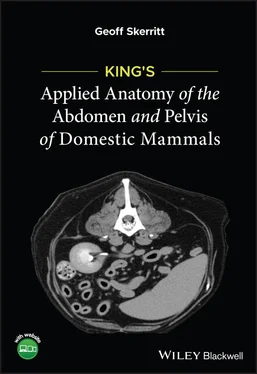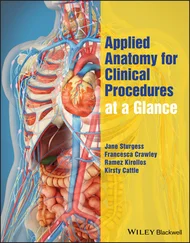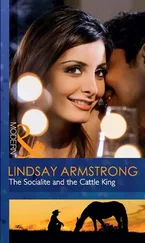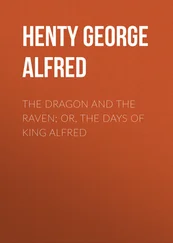Geoff Skerritt - King's Applied Anatomy of the Abdomen and Pelvis of Domestic Mammals
Здесь есть возможность читать онлайн «Geoff Skerritt - King's Applied Anatomy of the Abdomen and Pelvis of Domestic Mammals» — ознакомительный отрывок электронной книги совершенно бесплатно, а после прочтения отрывка купить полную версию. В некоторых случаях можно слушать аудио, скачать через торрент в формате fb2 и присутствует краткое содержание. Жанр: unrecognised, на английском языке. Описание произведения, (предисловие) а так же отзывы посетителей доступны на портале библиотеки ЛибКат.
- Название:King's Applied Anatomy of the Abdomen and Pelvis of Domestic Mammals
- Автор:
- Жанр:
- Год:неизвестен
- ISBN:нет данных
- Рейтинг книги:5 / 5. Голосов: 1
-
Избранное:Добавить в избранное
- Отзывы:
-
Ваша оценка:
- 100
- 1
- 2
- 3
- 4
- 5
King's Applied Anatomy of the Abdomen and Pelvis of Domestic Mammals: краткое содержание, описание и аннотация
Предлагаем к чтению аннотацию, описание, краткое содержание или предисловие (зависит от того, что написал сам автор книги «King's Applied Anatomy of the Abdomen and Pelvis of Domestic Mammals»). Если вы не нашли необходимую информацию о книге — напишите в комментариях, мы постараемся отыскать её.
King’s Applied Anatomy of the Abdomen and Pelvis of the Domestic Mammals King’s Applied Anatomy of the Abdomen and Pelvis of the Domestic Mammals
King's Applied Anatomy of the Abdomen and Pelvis of Domestic Mammals — читать онлайн ознакомительный отрывок
Ниже представлен текст книги, разбитый по страницам. Система сохранения места последней прочитанной страницы, позволяет с удобством читать онлайн бесплатно книгу «King's Applied Anatomy of the Abdomen and Pelvis of Domestic Mammals», без необходимости каждый раз заново искать на чём Вы остановились. Поставьте закладку, и сможете в любой момент перейти на страницу, на которой закончили чтение.
Интервал:
Закладка:
2.2 Functions of the Alimentary Tract
These may be considered under the following four principal headings:
1 Transport
2 Physical treatment
3 Chemical treatment
4 Absorption.
2.2.1 Transport of food
Food transport, i.e. the active passage through the digestive tract, is promoted by the musculature that is located throughout the entire length of the digestive tract. There are two muscular coats comprising an inner circular and an outer longitudinal layer, together with a variable layer of oblique fibres. Contractions of the muscle layers promote the propulsion of food through the gastrointestinal tract, and segmental contractions ensure mixing of the intestinal contents.
In the oesophagus these layers are made up either wholly of striated skeletal muscle or partly of striated skeletal muscle and partly of smooth muscle. In the remainder of the tract the muscle layers comprise only smooth muscle innervated by the autonomic nervous system, which may either stimulate or inhibit muscular contraction. The muscle fibres can also operate independently of the nervous system; intermittent excitation is an intrinsic property of smooth muscle cells themselves, electrical transmission from muscle cell to muscle cell taking place at sites of low electrical resistance where one cell is in close apposition to another as at gap junctions. These are intimate connections between the cytoplasm of cells that allow the interchange of molecules, ions and electrical impulses.
Entry of food through the cardia into the stomach can occur following receptive relaxation of the smooth muscle of the gastric wall. The arrival of food boluses,round masses of food mixed with saliva, results in a vagal reflex that induces inhibition of muscle tone.
Transport is brought about by progressive waves of muscular contraction known as peristalsis. This results in a travelling constriction of the circular muscles arising at a point just cranial to the side of the food mass or bolusthat has the effect of pushing the food caudally along the tract. Peristalsis occurs in the oesophagus, stomach and small intestines. Peristalsis also occurs in the large intestines, though the time interval between contractions is longer. An additional factor in the transport of food is the production of mucusby cells of the lining epithelium, thereby lubricating the passage of food along the intestines.
2.2.2 Physical treatment of food
To facilitate the action of enzymes upon the food taken into the digestive tract, it is necessary that the food be reduced to a soft pulp known as chyme. This is achieved largely by two types of contractile movement of the small intestines: (i) segmenting movements, which are single non‐travelling constrictions of the muscular wall and have the effect of churning and mixing the food; and (ii) pendular movements that involve primary contractions of the longitudinal muscle and that induce marked shortening of individual loops of the intestines and consequently shaking the contained chyme from one end of the loop to another.
2.2.3 Chemical treatment of food
Water, salts and vitamins can be absorbed directly by the appropriate lining cells of the intestines, whereas enzymes and certain other substances are needed for the prior breakdown of proteins, carbohydrates and fats. These enzymes are produced and secreted by cells within the digestive tract, that is, by cells lining the stomach and intestines, and by glands external to the digestive tract. The latter comprise the salivary glands, liver and pancreas, which are derived embryologically from the developing digestive tract and are important sources not only of enzymes but also of other substances such as bile salts that are involved in the emulsification of fats. The production of enzymes to facilitate the breakdown of food in the digestive tract represents a marked degree of specialisation on the part of the cells concerned, since the enzymes are produced in large quantities and are then secreted to act beyond the confines of the producer cells. All body cells produce a variety of enzymes, but in general these act intracellularly.
An important additional facility to the above general mammalian pattern occurs in herbivores, where special provision is made for the breakdown of cellulose by bacterial fermentation, and in these species one portion of the digestive tract has structural modifications for this purpose; these modifications include the additional compartments of the stomach of the ruminant and the greatly enlarged caecum and colon of the horse.
2.2.4 Absorption
Following the physical and chemical treatment of the food and the breakdown of the major constituents into simple sugars, amino acids, fatty acids, etc., these relatively simple substances are absorbed by the columnar cells that line the small intestines and, to a lesser extent, the large intestines.
To facilitate absorption, and to increase the available surface area for absorption, various adaptations characterise the small intestines. The following are of particular significance: (i) in most mammalian species the small intestine is extremely long, as much as many times the length of the body. To accommodate this within the abdominal cavity, the small intestine is extensively coiled and is suspended as festoonsby the peritoneal sheets of the mesentery. (ii) Crescentic folds of the internal lining membrane (the mucous membrane) occur, known as the plicae circulares(or the valves of Kerkring). (iii) Tiny finger‐like projections of the lining mucous membrane are present in vast numbers along the length of the small intestine. They are covered by absorptive and mucus‐secreting cells, and with a core of connective tissue, smooth muscle cells, blood vessels and lacteals, channels for transport of fat. These minute projections, known as villi, enormously increase the area for absorption. (iv) Finally, at the cellular level, at the luminal surface of each absorptive cell, the cell membrane is itself thrown into submicroscopic projections known as microvilli, which further increase the available absorptive surface.
2.3 Regions of the Alimentary Tract ( Figure 2.1)

Figure 2.1 The general arrangement of the intestines of the domestic mammals. The diagrams of the mammalian gastrointestinal tracts are drawn from the dorsal view although the ruminant intestinal spiral and the abomasum are displaced to the right by the rumen. The duodenum is V‐shaped with the ascending limb lying dorsally on the right at the level of the base of the caecum (mauve). The stomach and the duodenum are both coloured green on the diagram. The jejunoileum is not shown on the diagram but occupies a large space between the duodenum and the colon mainly on the right. The transverse and descending colon retain their basic position. The transverse colon passes cranial to the root of the mesentery which contains the cranial mesenteric artery (red circle).
In the higher vertebrates the regions of the tract comprise the oesophagus, stomach, small intestine, large intestine and rectum. In ruminant herbivores (e.g. the ox) the stomach is very large and divided into four distinct regions, each with its own structure and function (see Sections 4.1 and 4.2.). The small intestine comprises the duodenum, jejunum and ileum (although these two divisions are ill‐defined and are termed the jejunoileum). The large intestine in most species comprises a fairly long portion known as the colon, with a relatively short blind‐ending diverticulum known as the caecum. However, there are wide species variations, and in some herbivores (e.g. the horse), the caecum is very large (see Section 6.2.1).
Читать дальшеИнтервал:
Закладка:
Похожие книги на «King's Applied Anatomy of the Abdomen and Pelvis of Domestic Mammals»
Представляем Вашему вниманию похожие книги на «King's Applied Anatomy of the Abdomen and Pelvis of Domestic Mammals» списком для выбора. Мы отобрали схожую по названию и смыслу литературу в надежде предоставить читателям больше вариантов отыскать новые, интересные, ещё непрочитанные произведения.
Обсуждение, отзывы о книге «King's Applied Anatomy of the Abdomen and Pelvis of Domestic Mammals» и просто собственные мнения читателей. Оставьте ваши комментарии, напишите, что Вы думаете о произведении, его смысле или главных героях. Укажите что конкретно понравилось, а что нет, и почему Вы так считаете.












